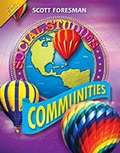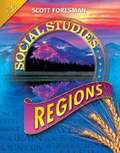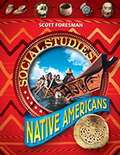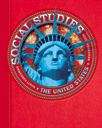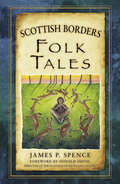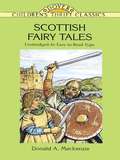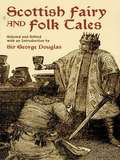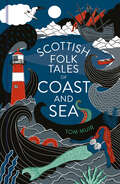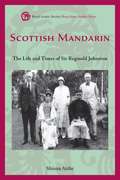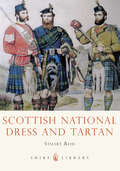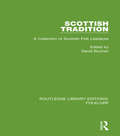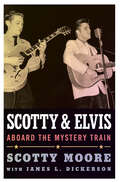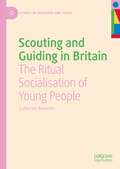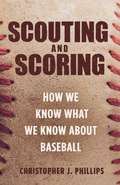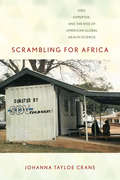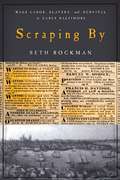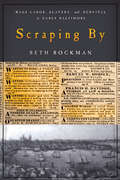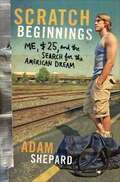- Table View
- List View
Scott Foresman Social Studies, Communities (Illinois)
by Inc. Pearson EducationNIMAC-sourced textbook
Scott Foresman Social Studies, Regions
by Candy Dawson Boyd C. Frederick Risinger Geneva Gay Rita Geiger James B. Kracht Valerie Ooka Pang Sara Miranda SanchezNIMAC-sourced textbook
Scott Foresman Social Studies, Regions
by Candy Dawson Boyd Geneva Gay Rita GeigerNIMAC-sourced textbook
Scott Foresman Social Studies: Alabama History Grade 4
by Scott ForesmanA reference tool is any source of information. Books are reference tools. Libraries often have reference books such as atlases, almanacs, dictionaries, and encyclopedias. Usually, reference materials cannot be checked out of the library, but you can use them to look up information while you are at the library. An encyclopedia is a collection of articles, listed alphabetically, on various topics. "When you need information quickly, an encyclopedia is a good choice. Electronic encyclopedias, available on the Internet or CD-ROM, have sound and video clips in addition to text. A dictionary is an alphabetical collection of words, their spellings, their meanings, and their pronunciations. If you find a word you don't understand, you can look it up in a dictionary. Many dictionaries also include abbreviations and information about well-known people and places.
Scott Foresman Social Studies: All Together Workbook 1st Grade (LA)
by Scott ForesmanSocial Studies workbook
Scott Foresman Social Studies: Native Americans
by Scott ForesmanIn this book you will learn about many different groups of Native Americans. These groups are different from one another, but they all had one thing in common. Geography affected how they lived.
Scott Foresman Social Studies: The United States
by Candy Dawson Boyd C. Frederick Risinger Geneva Gay Rita Geiger James B. Kracht Valerie Ooka PangSocial studies textbook for 5th grade students.
Scottish Borders Folk Tales (Folk Tales)
by Donald Smith James SpenceThis lively and entertaining collection of folk tales from the Scottish Borders is rich in stories both tall and true, ancient and recent, dark and funny, fantastical and powerful. Here you will find the Lochmaben Harper, Tam Linn, Thomas the Rhymer, Muckle Mou’d Meg and Michael Scott the wizard. These well-loved and magical stories – some appearing in print here for the first time – are retold in an engaging style, shaped by James Spence’s many years of storytelling. Richly illustrated and enlivened by the rhythmic Scots language of the region, these enchanting tales are sure to be enjoyed and shared time and again.
Scottish Fairy Tales: Unabridged In Easy-To-Read Type (Dover Children's Thrift Classics)
by John Green Donald A. MackenzieColorful stories from ancient and modern Scottish sources will charm young readers with the deeds of mermaids, giants and other supernatural creatures. Includes "Battle of the Fairy Kings," "Conall and the Thunder Hag," "In the Kingdom of Seals," "The Maid-of-the-Wave," "The Land of Green Mountains," and many more. 34 illustrations.
Scottish Fairy and Folk Tales
by George DouglasTreasury of fanciful, picturesque narratives tell of brownies, kelpies, mermen, and other supernatural creatures that assist, annoy, and otherwise meddle in the lives of simple Scottish country folk. A delightful collection of imaginative and entertaining nursery and fairy tales, animal fables, witchcraft lore, and stories with a comic twist.
Scottish Folk Tales of Coast and Sea (Folk Tales)
by Tom MuirA collection of Scottish coastal folk tales. 'The sea is in our blood and our stories.'
Scottish Mandarin
by Shiona AirlieColonial administrator, writer, explorer, Buddhist, and friend to China's last emperor, Sir Reginald Johnston (1874-1938) was a distinguished sinologist with a tangled love and family life that he kept secret even from his closest friends. Born and educated in Edinburgh, he began his career in the colony of Hong Kong and eventually became Commissioner of the remote British leased territory of Weihai in northern China. He travelled widely and, during a break from colonial service, served as tutor and advisor to Puyi, the deposed emperor. As the only foreigner allowed to work in the Forbidden City, he wrote the classic account of the last days of the Qing Dynasty--Twilight in the Forbidden City'.
Scottish National Dress and Tartan
by Stuart ReidTartan is an enormously popular pattern in modern fashion and Scottish National Dress is recognised around the world. This book reveals the origin and development of tartans and Scottish national costume. Beginning as Highland dress, it was originally peculiar to certain areas of Scotland but is now generally accepted as its national costume.What was once ordinary working clothing of a distinctive local style has been formalised and embellished to turn it into a ceremonial dress suitable for days of celebration, while tartans once woven according to the fancy of those who wore them, have also become fixed with certain patterns prescribed for different families, areas or institutions. This process was not, as is popularly thought, a phenomenon begun by the romantic novels of Sir Walter Scott, but began long before as a reaction to the Union with England in 1707. This book not only traces its evolution from earliest time, but the process by which it became Scottish National Dress.TOC: Chapter I: The Highland Clans /Chapter II: Early Highland Dress /Chapter III: Rebels and Kilts /Chapter IV: Invention of Scottish National Dress /Chapter V: Tartan - a national dress /Chapter VI Scottish National Dress today /Appendix: Major Tartans
Scottish Tradition: A Collection of Scottish Folk Literature (Routledge Library Editions: Folklore)
by David BuchanScottish folk literature is characterised by a wide range of creative expression: story, song, play and proverb. This anthology, first published in 1984, provides an authoritative introduction to Scottish folk literature, and is unique in that it deals with all the genres intrinsic to Scottish tradition. Its selected texts offer an unusual and diverse enjoyment to the reader, including such forms as wonder tales or Märhcen, classical ballads, riddles, jocular tales, lyric and comic and occupational folksongs, rhymes, historical and supernatural legends, and guisers’ plays. The texts chosen cover the main regional traditions of Lowland Scotland, from Galloway to the Shetlands, and span a number of centuries, through both pre- and post-industrial periods, from a sailor’s worksong of the sixteenth century to modern urban legends just recently recorded. The book is arranged in four sections, on Folk Narrative, Folksong, Folksay, and Folk Drama, each with an introduction and a bibliographical essay setting the material in context and indicating some of its international links. Folk literature itself is brought into firm focus by discussion and generic example, and the anthology as a whole illuminates substantial areas of Scottish social and cultural life.
Scotty and Elvis: Aboard the Mystery Train (American Made Music Series)
by Scotty MooreWhen Elvis Presley first showed up at Sam Phillips's Memphis-based Sun Records studio, he was a shy teenager in search of a sound. Phillips invited a local guitarist named Scotty Moore to stand in. Scotty listened carefully to the young singer and immediately realized that Elvis had something special. Along with bass player Bill Black, the trio recorded an old blues number called “That's All Right, Mama.” It turned out to be Elvis's first single and the defining record of his early style, with a trilling guitar hook that swirled country and blues together and minted a sound with unforgettable appeal. Its success launched a whirlwind of touring, radio appearances, and Elvis's first break into movies. Scotty was there every step of the way as both guitarist and manager, until Elvis's new manager, Colonel Tom Parker, pushed him out. Scotty and Elvis would not perform together again until the classic 1968 “comeback” television special. Scotty never saw Elvis after that. With both Bill Black and Elvis gone, Scotty Moore is the only one left to tell the story of how Elvis and Scotty transformed popular music and how Scotty created the sound that became a prototype for so many rock guitarists to follow. Thoroughly updated, this edition delivers guitarist Scotty Moore's story as never before.
Scout Camp: Sex, Death, and Secret Societies Inside the Boy Scouts of America
by James RennerIn this timely and deeply personal true crime memoir, acclaimed journalist, author, creator of the True Crime This Week podcast, and former Boy Scout James Renner, explores the dark side of an American institution, its pervasive culture of sexual abuse, and the traumatic—even deadly—repercussions of its long-buried secrets. In the summer of 1995, at the largest Boy Scout camp in Ohio, a night of sexual violence ended with one counselor dead and another hospitalized. The death was ruled &“accidental.&” It wouldn&’t be the last death associated with Seven Ranges Reservation. James Renner, too, was a counselor at Seven Ranges that year. He was always sure there must be more to the story of Mike Klingler&’s death, because Renner also knew firsthand that the 900-acre camp was not the safe getaway it was portrayed to be. On Friday nights the boys were ushered into the woods for a frightening ceremony in which they learned the rules for becoming good young men—and, above all, that keeping secrets was a Scout&’s duty. No matter how dark the secrets were. Determined to face his demons, Renner embarks on a journey back to that tumultuous summer and exposes a clandestine society that left indelible scars on the Scouts and the staff who were there. For Renner, it meant opening up about his twisted upbringing, his issues with trust and sexuality, and a lifetime of self-medication. The result is a deeply personal, no-holds-barred, and vitally important true crime memoir.
Scouting and Guiding in Britain: The Ritual Socialisation of Young People (Studies in Childhood and Youth)
by Catherine BannisterThis book explores the prevailing role of rites of passage, ritual, and ceremony in contemporary children’s lives through the lens of modern-day incarnations of uniformed youth movements. It focuses on the socialising ritual and customary practices of present-day grass-roots Scout and Guide groups, asking how Britain’s largest and best-known uniformed youth organisations employ ritualised activities to express their values to their young members through language and gesture, story and song, dress, and physical artifacts. The author shows that these practices exist against a backdrop of culturally-constructed beliefs about what constitutes the ‘good child’ and ‘good childhood’ in twenty-first century Britain, with in-movement practices intended to help children develop positively and prepare for social life. The book draws on case study accounts of group performances, incorporating the voices of children and adults reflecting on their practices and experiences.
Scouting and Scoring: How We Know What We Know about Baseball
by Christopher PhillipsAn in-depth look at the intersection of judgment and statistics in baseballScouting and scoring are considered fundamentally different ways of ascertaining value in baseball. Scouting seems to rely on experience and intuition, scoring on performance metrics and statistics. In Scouting and Scoring, Christopher Phillips rejects these simplistic divisions. He shows how both scouts and scorers rely on numbers, bureaucracy, trust, and human labor in order to make sound judgments about the value of baseball players.Tracing baseball’s story from the nineteenth century to today, Phillips explains that the sport was one of the earliest and most consequential fields for the introduction of numerical analysis. New technologies and methods of data collection were supposed to enable teams to quantify the drafting and managing of players—replacing scouting with scoring. But that’s not how things turned out. Over the decades, scouting and scoring started looking increasingly similar. Scouts expressed their judgments in highly formulaic ways, using numerical grades and scientific instruments to evaluate players. Scorers drew on moral judgments, depended on human labor to maintain and correct data, and designed bureaucratic systems to make statistics appear reliable. From the invention of official scorers and Statcast to the creation of the Major League Scouting Bureau, the history of baseball reveals the inextricable connections between human expertise and data science.A unique consideration of the role of quantitative measurement and human judgment, Scouting and Scoring provides an entirely fresh understanding of baseball by showing what the sport reveals about reliable knowledge in the modern world.
Scrambling For Africa: AIDS, Expertise, and the Rise of American Global Health Science (Expertise: Cultures and Technologies of Knowledge)
by Johanna Tayloe CraneCountries in sub-Saharan Africa were once dismissed by Western experts as being too poor and chaotic to benefit from the antiretroviral drugs that transformed the AIDS epidemic in the United States and Europe. Today, however, the region is courted by some of the most prestigious research universities in the world as they search for resource-poor hospitals in which to base their international HIV research and global health programs. In Scrambling for Africa, Johanna Tayloe Crane reveals how, in the space of merely a decade, Africa went from being a continent largely excluded from advancements in HIV medicine to an area of central concern and knowledge production within the increasingly popular field of global health science. Drawing on research conducted in the U. S. and Uganda during the mid-2000s, Crane provides a fascinating ethnographic account of the transnational flow of knowledge, politics, and research money as well as blood samples, viruses, and drugs. She takes readers to underfunded Ugandan HIV clinics as well as to laboratories and conference rooms in wealthy American cities like San Francisco and Seattle where American and Ugandan experts struggle to forge shared knowledge about the AIDS epidemic. The resulting uncomfortable mix of preventable suffering, humanitarian sentiment, and scientific ambition shows how global health research partnerships may paradoxically benefit from the very inequalities they aspire to redress. A work of outstanding interdisciplinary scholarship, Scrambling for Africa will be of interest to audiences in anthropology, science and technology studies, African studies, and the medical humanities.
Scraping By: Wage Labor, Slavery, and Survival in Early Baltimore
by Seth RockmanEnslaved mariners, white seamstresses, Irish dockhands, free black domestic servants, and native-born street sweepers all navigated the low-end labor market in post-Revolutionary Baltimore. Seth Rockman considers this diverse workforce, exploring how race, sex, nativity, and legal status determined the economic opportunities and vulnerabilities of working families in the early republic. In the era of Frederick Douglass, Baltimore's distinctive economy featured many slaves who earned wages and white workers who performed backbreaking labor. By focusing his study on this boomtown, Rockman reassesses the roles of race and region and rewrites the history of class and capitalism in the United States during this time. Rockman describes the material experiences of low-wage workers—how they found work, translated labor into food, fuel, and rent, and navigated underground economies and social welfare systems. He also explores what happened if they failed to find work or lost their jobs. Rockman argues that the American working class emerged from the everyday struggles of these low-wage workers. Their labor was indispensable to the early republic’s market revolution, and it was central to the transformation of the United States into the wealthiest society in the Western world. Rockman’s research includes construction site payrolls, employment advertisements, almshouse records, court petitions, and the nation’s first "living wage" campaign. These rich accounts of day laborers and domestic servants illuminate the history of early republic capitalism and its consequences for working families.
Scraping By: Wage Labor, Slavery, and Survival in Early Baltimore (Studies in Early American Economy and Society from the Library Company of Philadelphia)
by Seth RockmanCo-winner, 2010 Merle Curti Award, Organization of American HistoriansWinner, 2010 Philip Taft Labor History Book Award, ILR School at Cornell University and the Labor and Working-Class History AssociationWinner, 2010 H. L. Mitchell Award, Southern Historical AssociationEnslaved mariners, white seamstresses, Irish dockhands, free black domestic servants, and native-born street sweepers all navigated the low-end labor market in post-Revolutionary Baltimore. Seth Rockman considers this diverse workforce, exploring how race, sex, nativity, and legal status determined the economic opportunities and vulnerabilities of working families in the early republic.In the era of Frederick Douglass, Baltimore's distinctive economy featured many slaves who earned wages and white workers who performed backbreaking labor. By focusing his study on this boomtown, Rockman reassesses the roles of race and region and rewrites the history of class and capitalism in the United States during this time. Rockman describes the material experiences of low-wage workers—how they found work, translated labor into food, fuel, and rent, and navigated underground economies and social welfare systems. He also explores what happened if they failed to find work or lost their jobs. Rockman argues that the American working class emerged from the everyday struggles of these low-wage workers. Their labor was indispensable to the early republic’s market revolution, and it was central to the transformation of the United States into the wealthiest society in the Western world. Rockman’s research includes construction site payrolls, employment advertisements, almshouse records, court petitions, and the nation’s first "living wage" campaign. These rich accounts of day laborers and domestic servants illuminate the history of early republic capitalism and its consequences for working families.
Scraps Of The Untainted Sky: Science Fiction, Utopia, Dystopia
by Thomas MoylanDystopian narrative is a product of the social ferment of the twentieth century. A hundred years of war, famine, disease, state terror, genocide, ecocide, and the depletion of humanity through the buying and selling of everyday life provided fertile ground for this fictive underside of the utopian imagination. From the classical works by E. M. Forster, Yevgeny Zamyatin, Aldous Huxley, George Orwell, and Margaret Atwood, through the new maps of hell in postwar science fiction, and most recently in the dystopian turn of the 1980s and 1990s, this narrative machine has produced challenging cognitive maps of the given historical situation by way of imaginary societies which are even worse than those that lie outside their authors' and readers' doors.In Scraps of the Untainted Sky , Tom Moylan offers a thorough investigation of the history and aesthetics of dystopia. To situate his study, Moylan sets out the methodological paradigm that developed within the interdisciplinary fields of science fiction studies and utopian studies as they grow out of the oppositional political culture of the 1960 and 1970s (the context that produced the project of cultural studies itself). He then presents a thorough account of the textual structure and formal operations of the dystopian text. From there, he focuses on the new science-fictional dystopias that emerged in the context of the economic, political, and cultural convulsions of the 1980s and 1990s, and he examines in detail three of these new "critical dystopias:" Kim Stanley Robinson's The Gold Coast, Octavia Butler's The Parable of the Sower , and Marge Piercy's He, She, and It .With its detailed, documented, and yet accessible presentation, Scraps of the Untainted Sky will be of interest to established scholars as well as students and general readers who are seeking an in-depth introduction to this important area of cultural production.
Scratch Beginnings: Me, $25, and the Search for the American Dream
by Adam W. ShepardA young man sets out to prove the American Dream is alive and well in this memoir of homelessness, grit, and perseverance.After reading Barbara Ehrenreich's influential book, Nickel and Dimed, Adam Shepard felt discouraged by its hopeless view of American opportunity. He set out to disprove Ehrenreich's theory—the notion that those who start at the bottom stay at the bottom—by making something out of nothing to achieve the American Dream.Shepard's plan was simple. With a sleeping bag, the clothes on his back, and $25 in cash, and restricted from using his contacts or college education, he headed out for Charleston, South Carolina, a randomly selected city with one objective: to work his way out of homelessness and into a life that would give him the opportunity for success. His goal was to have, after one year, $2,500, a working automobile, and a furnished apartment.Scratch Beginnings is a personal account of Shepard's struggle to overcome the pressures placed on the homeless. His story will not only inspire readers but will also remind them that success can come to anyone who is willing to work hard—and that America is still one of the most hopeful countries in the world.
